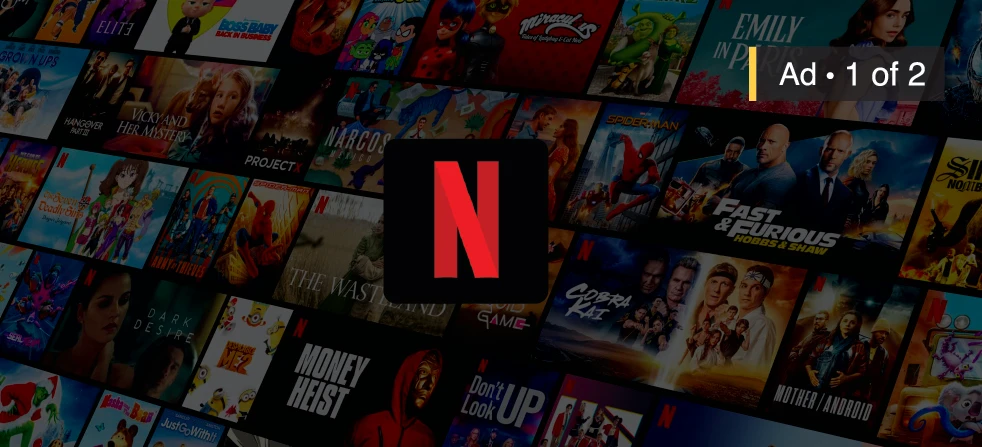
Should Brands Advertise on Netflix?
After arguing against ads for almost a decade, Netflix finally launched its ad-supported tier in November 2022. Unlike its streaming rivals, Netflix shares no impressions data with demand-side partners such as Tatari. As a result, TV marketers have no visibility into the performance or effectiveness of their campaigns. This lack of measurement, combined with the sky-high CPM pricing, has led to very few brands jumping on the Netflix bandwagon. This is, however, not the end of the story. We decided to dig a little deeper into the numbers (i.e. beyond Netflix subscriber growth) and explore if there’s still a case to be made for performance-minded TV marketers.
Ad loads vs response rates
Streaming publishers have touted light ad loads (how many times ads are shown per hour) as a way to keep both users and advertisers happy. With fewer ads, consumers will have a better viewing experience; at the same time, advertisers face less competition for their ads. Netflix too has promised light ad loads. Will this lead to positive ad performance on Netflix, then? Without IP-passback to measure performance metrics (e.g. CAC or ROAS), it is hard to say.
We can, however, find our cues by quantifying the relationship between ad load and response rate across other premium streaming publishers. In this case, response rate is calculated by the number of site visits (or app downloads) by impressions. We mapped external data on premium streaming publishers’ average ad load with Tatari’s internal data on incremental response rates and found that the lighter the ad load, the higher the response rate (see table below). One could therefore reasonably assume that Netflix, with a lighter ad load compared to other publishers, will bring in higher response rates. Now…that is great news for response-focused advertisers.
But wait, there’s more!
If the above isn’t sufficiently compelling, maybe some of the following facts below are. First of all, the number of ad-supported Netflix households is (finally) taking shape. This March, Netflix reported one million new subscribers, up from just a mere hundred thousand only a few months ago. Considering that Netflix is not a newbie to the streaming world and enjoys a favorable reputation for great content, we suspect a faster adoption rate of its ad-supported tier. Phrased differently, it shouldn't take too long for Netflix to catch up with the incumbents (e.g. Hulu, Peacock, etc.) in terms of reach and the ability to drive mass awareness for a brand. Second, with so few brands currently on Netflix, any brand jumping in today has a shot at being “category-leader.” It will enjoy an outsized share of voice, which is well understood to be a key driver for future market share. Last but not least, advertising on Netflix today signals quality and prestige. Early adopters will be featured and shine along big established brands such as Google, Cadillac, and Subway. Doesn’t it feel a bit like the Super Bowl?
What this means for streaming TV advertisers
Based on all the above, we believe there is a good case to be made for advertising on Netflix. Tatari is one of the few TV ad technology platforms with inventory access.
For brands with large budgets, we can actually still help you ascertain the performance of Netflix (e.g. based on geo-test, media-mix modeling, etc.). For smaller budgets, in a diversified strategy with other publishers (e.g. Hulu, Fubo, Tubi, etc.), it is safe to assume there’s going to be a benefit, even if not exactly quantifiable.
If you are interested in learning about streaming publishers' minimum ad spend, content, targeting, ad formats, and more download our Buyer’s Guide to Streaming Advertising, or talk to us today!

Vicky Chang
I love helping businesses grow.
Related
Adding Brand Objectives to a Performance-Focused TV Ad Strategy
Let’s take a look at how three Tatari clients, Nutrafol, Tecovas, and Ro, started their TV journey with a performance-focused mindset and later added brand objectives to drive even stronger campaign results.
Read more
Marketers are Enamored with the Big Screen but They Risk Missing the Bigger Picture
Whilst there is value in targeting, it leads brands to not fully harness the power of TV advertising. This is best explained by laying out a typical TV advertising journey (with related spend levels).
Read more
How Calm Used Digital Tactics to Master TV Brand Advertising
Learn how Calm used data & analytics to drive customer acquisition, found audiences at scale, and ultimately launched a large-scale brand campaign featuring NBA star LeBron James to become the No. 1 Mental Fitness App, with over 70 million downloads.
Read more


